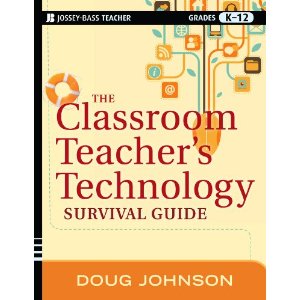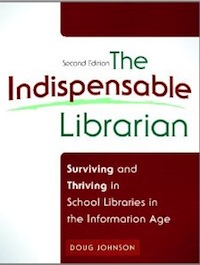The E-Book Non-plan
The E-Book Non-plan
Head for the Edge, October 2010
Doug Johnson
There must be something in the water lately since three of my corporate friends (yes, I have friends) called to pick my brain about what our district’s plan is for adding e-books to our libraries.
The plan is that there is no plan.
Those of you who’ve been reading this column for a while know I am very excited about e-books. And most of the things I wished for when I started writing about this technology in 1995 have come true. Devices like the Kindle, the Nook and the iPad have exceeded the expectations I had of e-book hardware and publishers are starting to envision exciting books that infuse multimedia with text and that are truly interactive.
So why have I been dragging my feet even thinking about how our district should be using e-books, let alone creating any pilot projects or a long-term implementation plan?
First let me qualify. We do use some types of e-books - non-fiction books (mostly reference) that are accessed on research stations or from home computers. Online encyclopedias, dictionaries and a state-provided collection of e-books are available. But the primary use of these is the extraction of relatively small passages of information - not extended reading.
Nor am I all that worried about electronic textbook adoption. I am guessing a clever publisher will soon offer free e-book readers to schools as part of multi-year subscriptions to textbook series, using the same economic model cell phone companies use in giving hardware away with long-term contracts.
My hesitation stems from how we deal with longer narrative works – fiction, biographies, and popular non-fiction. This kind of “e-book” is truly a technology in churn. As a public employee/educator I don’t want to buy a technology that makes choosing BetaMax look brilliant by comparison.
In order to avoid the ready-fire-aim approach to any technology implementation, I always look for two possible reasons a library might decide to invest time, effort, credibility and money in a new thing:
Head for the Edge, October 2010
Doug Johnson
There must be something in the water lately since three of my corporate friends (yes, I have friends) called to pick my brain about what our district’s plan is for adding e-books to our libraries.
The plan is that there is no plan.
Those of you who’ve been reading this column for a while know I am very excited about e-books. And most of the things I wished for when I started writing about this technology in 1995 have come true. Devices like the Kindle, the Nook and the iPad have exceeded the expectations I had of e-book hardware and publishers are starting to envision exciting books that infuse multimedia with text and that are truly interactive.
So why have I been dragging my feet even thinking about how our district should be using e-books, let alone creating any pilot projects or a long-term implementation plan?
First let me qualify. We do use some types of e-books - non-fiction books (mostly reference) that are accessed on research stations or from home computers. Online encyclopedias, dictionaries and a state-provided collection of e-books are available. But the primary use of these is the extraction of relatively small passages of information - not extended reading.
Nor am I all that worried about electronic textbook adoption. I am guessing a clever publisher will soon offer free e-book readers to schools as part of multi-year subscriptions to textbook series, using the same economic model cell phone companies use in giving hardware away with long-term contracts.
My hesitation stems from how we deal with longer narrative works – fiction, biographies, and popular non-fiction. This kind of “e-book” is truly a technology in churn. As a public employee/educator I don’t want to buy a technology that makes choosing BetaMax look brilliant by comparison.
In order to avoid the ready-fire-aim approach to any technology implementation, I always look for two possible reasons a library might decide to invest time, effort, credibility and money in a new thing:
- Can I do the same thing I’ve been doing, but a significant cost savings?
- Can I substantially improve learning opportunities for students and staff?
- What kind of device is required to read your e-books? What does it cost and how would you suggest I provide ready equipment access to all my students? Will your e-books work with many different devices or just one proprietary device? Can your e-books be read on a device that also allows productivity software (word processing, multimedia production, etc.) to be used and that had a good web browser?
- Can my patrons put your e-books on their personally owned, portable devices? Can more than one reader access an e-book at a time? Is there a time limit on how long a student can use one of your e-books? What is your electronic equivalent of the “first sale doctrine?”
- Can text from your e-books be copy/pasted into student documents? Can students bookmark, highlight and add notes to your e-text?
- How might your e-book collection be a better value than a print collection? Let’s use these numbers as a starting point. Print collection of 10,000 volumes = $200,000 investment. Book life-span 20 years. Used by 500 students. Cost of print collection per year per student: $20 (at 5% annual replacement rate.) Remember to factor in the cost of the equipment needed to read your e-books.
- Do your electronic texts offer any features that would help my learners, especially those who are beginning or struggling readers? Does you book convert text to speech, have a built in dictionary, illuminate concepts with video or animation, or use artificial intelligence to offer help? Do your e-books actually help kids read or just keep non-readers entertained? Are your e-books “social” - promoting group discussions, reviews, and commentary?
- If the collection is actually a subscription, not a purchase, how do I know that your company won’t increase the price to a point we can’t afford it? Or change the collection so that teachers can’t rely on having titles? Or that you won’t align with a single publisher or three and limit the access to titles by other publishers? How do I know the titles you are offering are high quality, aligned to the curriculum, and developmentally appropriate?
Any e-book implementation plan we have must increase access to books to more students for more of the time. And save the district money. At the present time, I believe libraries that are adding e-books are true pioneers and I applaud them. I hope they show us where the digital pitfalls are – and how we might avoid them.





Reader Comments